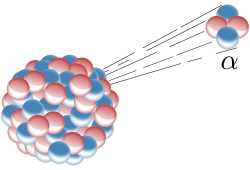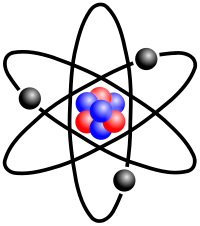- ^ The mass of the photon is believed to be exactly zero, based on experiment and theoretical considerations described in the article. Some sources also refer to the relativistic mass concept, which is just the energy scaled to units of mass. For a photon with wavelength λ or energy E, this is h/λc or E/c2. This usage for the term "mass" is no longer common in scientific literature. Further info: What is the mass of a photon? http://math.ucr.edu/home/baez/physics/ParticleAndNuclear/photon_mass.html
A lepton is an elementary particle and a fundamental constituent of matter.[1] The best known of all leptons is the electron which governs nearly all of chemistry as it is found in atoms and is directly tied to all chemical properties. Two main classes of leptons exist: charged leptons (also known as the electron-like leptons), and neutral leptons (better known as neutrinos). Charged leptons can combine with other particles to form various composite particles such as atoms and positronium, while neutrinos rarely interact with anything, and are consequently rarely observed.
A neutrino (![]() /njuːˈtriːnoʊ/; Italian pronunciation: [neuˈtriːno]) is an electrically neutral, weakly interacting elementary subatomic particle[1] with a half-integer spin, chirality and a disputed but small non-zero mass. It is able to pass through ordinary matter almost unaffected. The neutrino (meaning "small neutral one" in Italian) is denoted by the Greek letter ν (nu).
/njuːˈtriːnoʊ/; Italian pronunciation: [neuˈtriːno]) is an electrically neutral, weakly interacting elementary subatomic particle[1] with a half-integer spin, chirality and a disputed but small non-zero mass. It is able to pass through ordinary matter almost unaffected. The neutrino (meaning "small neutral one" in Italian) is denoted by the Greek letter ν (nu).
Most neutrinos passing through the Earth emanate from the Sun. About 65 billion (6.5×1010) solar neutrinos per second pass through every square centimeter perpendicular to the direction of the Sun in the region of the Earth.[2]

If you see protons and neutrons of the alpha particle (above) as being like balloons, filled with helium (an electric charge) but with the mass in the centre, (centre of mass), you will see how an atom uses electrons to create space between other electrons. The same could be true of protons and neutrons.
In particle physics, the lepton number is the number of leptons minus the number of antileptons.
In equation form,
so all leptons have assigned a value of +1, antileptons −1, and non-leptonic particles 0. Lepton number (sometimes also called lepton charge) is an additive quantum number, which means that its sum is preserved in interactions (as opposed to multiplicative quantum numbers such as parity, where the product is preserved instead).
Beside the leptonic number, leptonic family numbers are also defined:
- Le, the electronic number for the electron and the electron neutrino;
- Lμ, the muonic number for the muon and the muon neutrino;
- Lτ, the tauonic number for the tau and the tau neutrino;
with the same assigning scheme as the leptonic number: +1 for particles of the corresponding family, −1 for the antiparticles, and 0 for leptons of other families or non-leptonic particles.

In September 2011, neutrinos apparently moving faster than light were detected (see OPERA neutrino anomaly). Since then the experiment has undergone extensive critique and efforts to replicate the results because confirming the results would change our understanding of the theory of relativity. In November 2011, the experiment was refined and yielded the same result. (See Speed below)
Radiation pressure is the pressure exerted upon any surface exposed to electromagnetic radiation. If absorbed, the pressure is the power flux density divided by the speed of light. If the radiation is totally reflected, the radiation pressure is doubled. For example, the radiation of the Sun at the Earth has a power flux density of 1,370 W/m2, so the radiation pressure is 4.6 µPa (absorbed).

Stylized lithium-7 atom: 3 protons, 4 neutrons & 3 electrons (total electrons are ~1/4300th of the mass of the nucleus). It has a mass of 7.016 u Rare lithium-6 (mass of 6.015 u) has only 3 neutrons, reducing the atomic weight (average) of lithium to 6.941 u.
